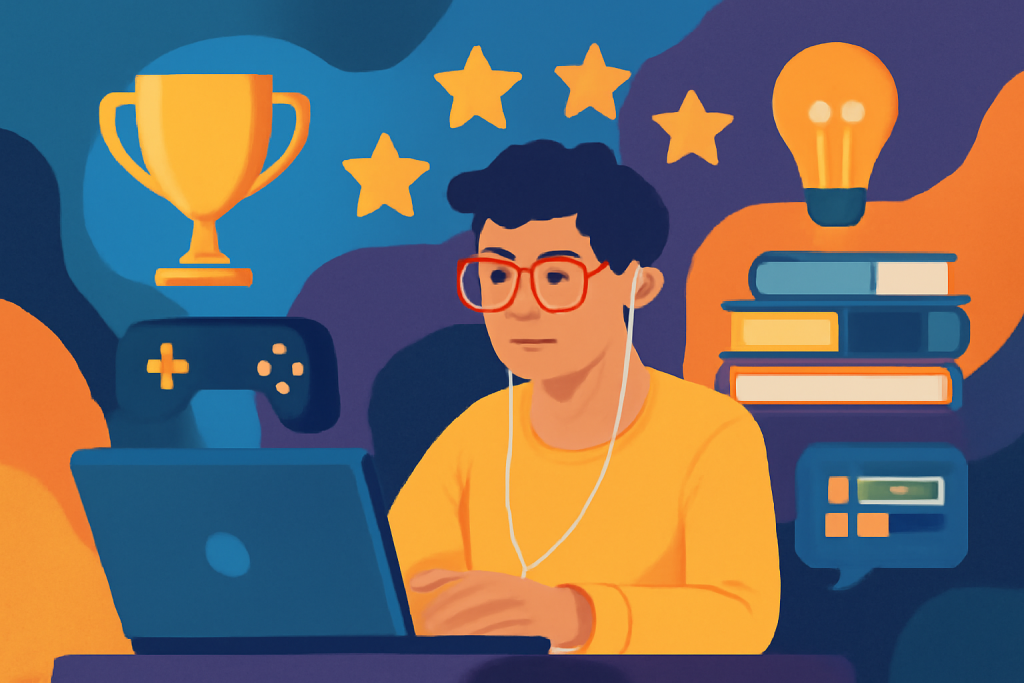Gamification has emerged as a powerful tool to boost learning and engagement. Today, a new trend is reshaping this landscape—AI-driven personalized gamification, which tailors game-based learning experiences uniquely to each learner, dramatically enhancing motivation, knowledge retention, and overall learner satisfaction.

Why Gamification in Learning Matters Now More Than Ever
Gamification—the integration of game mechanics such as points, leaderboards, challenges, and rewards into non-game environments—has long been recognized for making learning more interactive and enjoyable. This approach can transform tedious or complex educational content into engaging experiences that promote active participation.
With the dramatic rise in online education accelerated by global events such as the COVID-19 pandemic, keeping learners motivated and focused has become an even greater challenge. Engagement often drops when learners study remotely without direct supervision. Gamification can counteract this trend by creating immersive, rewarding experiences that foster ongoing participation.
Research shows that gamified learning can increase knowledge retention rates by as much as 60% compared to traditional lecture-based methods (Pappas, 2019). It encourages learners to progress through material by rewarding achievements and providing instant feedback—key drivers of sustained motivation.
However, many earlier gamification implementations suffered from a “one-size-fits-all” design, offering the same challenges and rewards regardless of individual learner differences. This limitation often resulted in disengagement when content was either too easy or too difficult for some users.
The Emergence of AI-Driven Personalized Gamification
The newest and most exciting trend in gamification is the integration of Artificial Intelligence (AI) to create highly personalized and adaptive learning journeys. AI-powered gamification platforms analyze learner interactions, performance, and preferences in real time to dynamically customize challenges, pacing, and incentives.
This personalization addresses the core issue of learner variability, ensuring that every user receives content and tasks tailored to their current skill level and interests, maximizing both effectiveness and engagement.
Key features of AI-driven gamification include:
- Adaptive learning paths: AI algorithms adjust the difficulty and type of challenges based on learner progress, ensuring optimal pacing.
- Tailored rewards: Rewards and incentives are customized to what motivates the individual learner, from badges and points to tangible rewards.
- Predictive analytics: AI identifies learner weaknesses early, allowing educators to intervene promptly.
- Social engagement: AI curates peer interactions, such as collaborative quests or competitive leaderboards, matching users with similar profiles.
MarketsandMarkets reports that the global AI in education market—propelled by such applications—is projected to grow at a compound annual growth rate (CAGR) of 45% between 2023 and 2028, highlighting significant investment and interest in smarter learning solutions (MarketsandMarkets, 2023).
How AI-Powered Gamification Boosts Engagement and Learning Outcomes
1. Real-Time Adaptation Keeps Learners in the “Flow” Zone
One major challenge in education is maintaining learners in the “flow” state—where the difficulty level is balanced perfectly between boredom and anxiety. AI-driven gamification platforms continuously analyze learner behavior and adjust content difficulty, keeping challenges just right to sustain interest and motivation.
For example, if a learner breezes through basic quizzes, the system ups the difficulty or introduces new types of tasks like puzzles or simulations. Conversely, if the learner struggles, it offers additional hints or simplifies tasks.
This continuous tailoring prevents frustration and disengagement, a common pitfall in less adaptive gamified systems.
2. Personalized Rewards Increase Motivation
Not every learner is motivated by the same type of reward. While some thrive on earning badges and climbing leaderboards, others might respond better to unlocking exclusive content or receiving feedback from instructors.
AI systems analyze engagement patterns to personalize the type and timing of rewards, making them more meaningful. For instance, a learner who enjoys social recognition may be encouraged by competitive rankings, whereas another learner may receive private motivational messages or digital collectibles.
This level of customization significantly improves learner satisfaction and encourages repeated participation.
3. Enhanced Social Learning Opportunities
Social interaction is a strong motivator for many learners. AI-driven gamification platforms facilitate peer learning by grouping learners with similar interests or complementary skill sets. This fosters collaborative quests, challenges, and even competitions, all tailored by AI to maximize social engagement.
Studies confirm that social learning through gamification boosts retention and deepens understanding because learners explain concepts to peers, receive immediate feedback, and experience a sense of community (Pappas, 2019).
Real-World Applications of AI-Driven Gamification
Corporate Training
Large enterprises are among the earliest adopters of AI-powered gamification. Deloitte, for instance, uses an AI-driven gamified platform for compliance and skills training, resulting in a 40% faster ramp-up time for employees and significantly higher completion rates (Deloitte, 2023).
By providing personalized training pathways, employees engage with relevant content at their own pace, avoiding the frustration of irrelevant modules. AI also helps trainers identify who needs additional support before performance issues arise.
K-12 and Higher Education
Educational technology companies are embedding AI-driven gamification into apps and platforms for K-12 students to make subjects like math, science, and language arts more engaging. Adaptive quizzes, badges, and interactive stories evolve based on learner responses, helping teachers provide individualized attention.
Universities, meanwhile, are integrating these systems into online courses to combat dropout rates. Early data suggest improvements in course completion and student satisfaction when adaptive gamification is used.
Professional Certifications and Skill Development
Platforms offering professional certifications now employ AI gamification to prepare learners for exams more efficiently. Tailored mock exams, progress tracking, and motivational rewards encourage continuous learning, resulting in higher pass rates.
How to Implement AI-Driven Gamification in Your Learning Programs
If you want to leverage AI-driven gamification to boost engagement, here’s a practical step-by-step guide:
- Analyze Learner Profiles: Gather data on learner demographics, preferences, and prior knowledge.
- Select an AI-Enabled Platform: Choose a platform with proven adaptive gamification features and strong analytics capabilities.
- Map Your Curriculum into Modular Content: Design bite-sized, gamified learning units that can be dynamically adjusted.
- Design Personalized Rewards: Incorporate a range of incentives to appeal to different learner motivations.
- Pilot Your Program: Test with a small learner group, collecting engagement data and feedback.
- Iterate Based on Data: Use AI analytics to continuously improve content difficulty, pacing, and rewards.
- Encourage Social Interaction: Add AI-curated collaborative and competitive features to increase motivation.
- Measure Impact: Track key performance indicators like retention rates, assessment scores, and learner satisfaction.
Challenges and Considerations
While AI-driven gamification offers exciting benefits, organizations must consider:
- Data Privacy: Collecting and analyzing learner data raises privacy concerns that must be addressed with secure, transparent policies.
- Resource Investment: High-quality AI gamification platforms and content development require upfront investment.
- Content Quality: The gamification should enhance—not overshadow—the learning content.
- Inclusivity: Ensure gamification elements are accessible to learners with disabilities.
Looking Ahead: The Future of AI and Gamification in Learning
As AI technologies like natural language processing and emotion recognition mature, we can expect gamified learning environments that not only adapt to cognitive skill but also emotional states, providing personalized encouragement or challenge based on learner mood.
Virtual reality (VR) and augmented reality (AR) combined with AI gamification will create immersive learning worlds responsive to learner input, making education deeply experiential.
In this evolving landscape, AI-driven personalized gamification will become a cornerstone of effective, engaging learning across industries.
Conclusion
Using gamification to boost learning and engagement has evolved significantly with the integration of AI. Personalized gamification platforms offer adaptive, learner-centered experiences that increase motivation, improve retention, and enable social collaboration. For educators and trainers, adopting AI-driven gamification isn’t just a trend—it’s a strategic imperative to meet the diverse needs of today’s learners and prepare for the future of education.
References
- Pappas, C. (2019) ‘The benefits of gamification in education’. eLearning Industry. Available at: https://elearningindustry.com/benefits-of-gamification-in-education (Accessed: 27 May 2025).
- MarketsandMarkets (2023) Artificial Intelligence in Education Market by Offering, Technology, Application, and Region – Global Forecast to 2028. Available at: https://www.marketsandmarkets.com/Market-Reports/artificial-intelligence-in-education-market-99503481.html (Accessed: 27 May 2025).
- Deloitte (2023) ‘How gamification is transforming corporate learning’. Deloitte Insights. Available at: https://www2.deloitte.com/insights/us/en/focus/human-capital-trends/2023/gamification-in-corporate-learning.html (Accessed: 27 May 2025).






